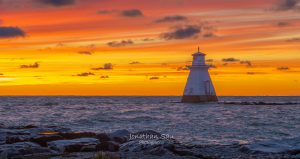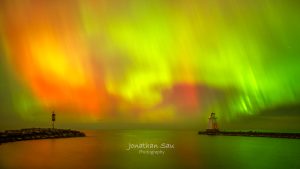Water
-
Great Lakes Sunset
Vibrant sunset by the Southampton Lighthouse.
-
Killarney Star Rise
“Killarney Star Rise” captures the experience of watching stars rising behind the picturesque Killarney Lighthouse, as evening twilight turns into darkness. A total of 135 separate exposures were used to compress this 80-minute experience into a single image. All individual exposures were taken with the same camera position and focal length to reflect the true trajectory of the rising stars in relation to the landscape.
What else do you see in this image? There are stars of different colours. The mass of each star, and the phase of stellar evolution it is at, determines the surface temperature of the star, and hence its colour (red is cool, blue is hot). Diphda, the brightest star on the right of the image, changes from dim red to bright yellow as it rises from the horizon. How does that happen? This is the exact same phenomenon we observe during sunrise – near the horizon, starlight and sunlight have to travel through a lot more atmosphere to reach us. The atmosphere dims the light and scatters the blue end of the spectrum, leaving predominantly red light through. And why do the stars rise at about 46 degrees off the vertical? That’s due to the latitude of Killarney at 46 degrees north. If we are at the equator looking east, stars will rise straight up from the horizon.
-
Northern Lights Reflection, Costello Creek
The northern lights were fleeting this night, but when they were shining, colourful red and green pillars filled the northern horizon and added vibrant hues to the Costello Creek in Algonquin Park. Northern lights were not in the forecast for the night, but when the Kp and Bz readings (both indicators of potential aurora activities) unexpectedly turned favourable, we ditched our plan for Milky Way photography and pivoted to northern lights, and we were not disappointed.
The northern Milky Way, Cassiopeia and the Double Cluster in Perseus are to the right of the aurora. The Andromeda Galaxy is a small fuzzy patch near the right edge of the image.
-
Setting Off at Dawn
“Killarney Lighthouse” series.
-
Golden Hour
“Killarney Lighthouse” series.
-
Evening Pastel
“Killarney Lighthouse” series.
-
Geminid Meteor Shower
Geminid meteor shower peaks every year around December 13 or 14. While the winter nights are chilly, those who brave the cold will be rewarded with a spectacular show. The Geminids are often bright, and surely plentiful. Under ideal conditions, one can expect to see upward of 120 meteors an hour. The radiant of the Geminids, the point where all the meteors appear to come from, is the constellation of Gemini (the Twins).
To create this composite image, the camera was placed on a star tracker and set to capture 4-second exposures continuously from 4 am to 6:30 am. The 11 meteors were in their correct positions relative to the stars, which were in turn in the correct positions relative to the landscape at 6:30 am.
-
Daybreak by the Lake
Morning fog, Lake of Two Rivers.
-
Northern Lights, Southampton
Northern lights shining over the Southampton Lighthouse in the evening of September 2, 2023, during a moderate (Kp 6) geomagnetic storm. The just-risen full moon illuminated the lighthouse, and turned the sky deep blue. The Kp index, which has a value from 0 to 9, is a measurement of geomagnetic activity. A Kp value of 5, indicating a minor geomagnetic storm, can bring on northern lights activity in southern Ontario.
-
October Storm (in the Magnetosphere)
A Kp 8 severe geomagnetic storm hit Earth through the night of October 10-11, 2024, sparking widespread northern through all of Canada, US and as far south as Puerto Rico and Mexico. Together with the Kp 9 storm on May 10-11, these were the strongest geomagnetic disturbances recorded in the past 20 years.
This image was taken in Southampton, Ontario around 10 pm, when the northern lights surged in strength and blanketed the entire sky. The most common colours of aurora are green (from oxygen at low altitude) and red (from oxygen at high altitude). The orange aurora seen in this image came from the mixing of red and green.
-
Peaceful Moonrise
“Killarney Lighthouse” series.
-
Southampton at Night
“Southampton at Night” – Star Trails photographed at the iconic Southampton Lighthouse.
This image can also be titled “Watching the World Goes Around”. Due to the Earth’s rotation, at night looking north, all stars revolve around the celestial north pole, the point in the sky that the Earth’s rotational axis goes through. Polaris, or the North Star, is the star closest to this point. The celestial north pole is just off the top edge of this image..
This image combined 11 exposures of 15 minutes each for a total exposure time of 2 hours 45 minutes. The last exposure extended into the morning twilight, providing the blue colour in the sky.












